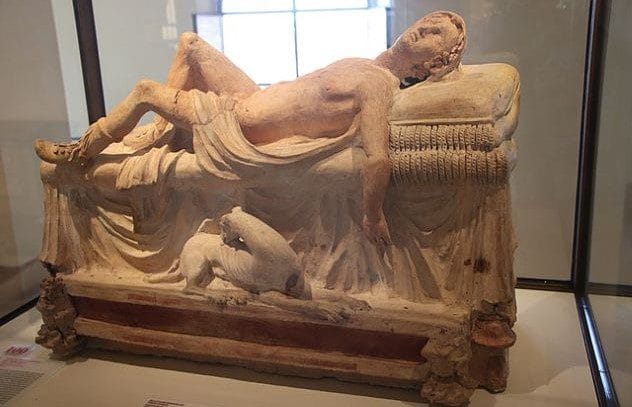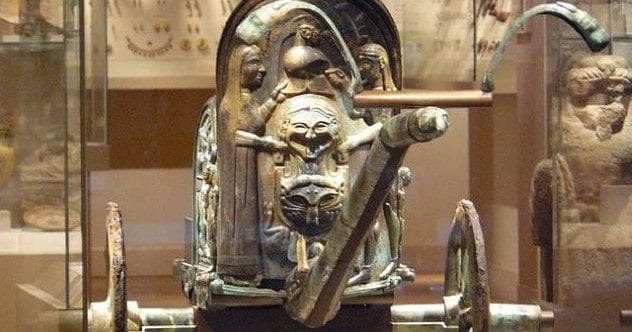The Etruscans, who once dominated northern Italy, left behind a legacy shrouded in mystery. Ruling from the Alps to Campania around the first century BC, they even held Rome within their sphere of influence. While their language faded, and their writings remain challenging to decipher, their artistic masterpieces offer tantalizing glimpses into their world. Let’s explore ten amazing artworks that showcase the Etruscan civilization’s ingenuity and cultural richness.
1. Apollo of Veii
Etruscan religion remains a complex puzzle for historians. Statues like the Apollo of Veii offer clues to the magnificence of their temples. Discovered at the Sanctuary of Minerva in Veii, the Apollo statue once stood on the roof of a temple. Dating back to around 500 BC, it reflects Greek artistic influences but remains distinctly Etruscan. The statue’s enigmatic smile and vivid colors, still visible today, bring the Etruscan artistry to life.
2. Mars of Todi
The Etruscans were renowned for their bronze work, a skill highly valued by the Romans. The Mars of Todi, despite its name, is a detailed bronze statue of a soldier, likely from the late 5th century BC. Discovered buried under rock slabs, it may have been ritually buried. An inscription in the Etruscan alphabet suggests it was made for Ahal Trutitis, possibly as thanks for surviving a battle. This statue exemplifies the Etruscan mastery of bronze casting and attention to detail.
3. Dying Adonis

The Etruscans had a strong belief in the afterlife, evident in their decorated tombs and sarcophagi. The Etruscan funerary monument in the Vatican Museum depicts Adonis in his final moments. Dating from the third century BC, this terracotta monument shows Adonis with a bleeding wound, referencing the Greek myth where he was injured by a wild boar. This artwork illustrates how the Etruscans integrated and reinterpreted myths from other cultures, reflecting their beliefs about death and rebirth.
4. Sarcophagus of Seianti Hanunia Tlesnasa
Etruscan tombs were personalized, offering unique insights into the lives of the deceased. The Sarcophagus of Seianti Hanunia Tlesnasa portrays an Etruscan woman from the 2nd century BC reclining and lifting a veil. Dressed in fine attire and a tiara, she is depicted in her best for the afterlife. The skull found inside the sarcophagus was used to reconstruct her face, confirming that the sculpture was indeed a flattering representation of Seianti Hanunia Tlesnasa.
5. Sarcophagus of the Spouses
Anthropoid sarcophagi provide a glimpse into Etruscan relationships. The Sarcophagus of the Spouses, dating from the 6th century BC, depicts a married couple reclining on a dining couch. The figures, with happy expressions and intricate hairstyles, are caught in mid-conversation. The similarity to another sarcophagus in the Louvre suggests this piece represents a generalized happy couple rather than specific individuals, reflecting Etruscan societal values.
6. Tomb of the Leopards
Etruscans were often buried in large necropolises with elaborately decorated tombs. The Tomb of the Leopards is famous for its painting of two leopards facing each other above a banquet scene. The diners, surrounded by food, musicians, and dancers, offer insights into Etruscan perceptions of the afterlife or funerary rituals. This tomb provides a colorful depiction of Etruscan social life and beliefs.
7. Monteleone Chariot
The Monteleone Chariot, dating from 530 BC, is one of the best-preserved chariots from the ancient world. Discovered in a tomb, it features thin sheets of decorated bronze depicting Achilles receiving armor from his mother, Thetis. Inlays of ivory, amber, and glass further enhance its artistic value. The chariot’s prior damage and subsequent repair before burial indicate the Etruscans respected their dead but weren’t extravagant in their funerary offerings.
8. Etruscan Jewelry
The Etruscans benefited from a vast trading network that brought wealth and skilled artisans. Etruscan jewelry, often made from high-purity gold, showcases intricate designs and influences from Greek legends and Egyptian motifs. The Vulci set of jewelry includes necklaces, earrings, and brooches adorned with glass pendants, rock crystal, and carved stones. The use of exotic materials like amber highlights the Etruscans’ extensive trade connections.
9. Etruscan Gold Book
Etruscan artifacts have been found across the Mediterranean, indicating their extensive trade and settlement activities. The Etruscan Gold Book, discovered in Bulgaria, comprises six gold sheets bound together and inscribed with images and Etruscan text. Similar golden plates with bilingual texts suggest connections to religious practices and the Etruscans’ cosmopolitan dealings with other cultures. This book is a testament to their widespread influence.
10. Chimera of Arezzo
The Chimera of Arezzo, dating from around 400 BC, is considered the greatest expression of Etruscan artistry. This bronze statue depicts a terrifying beast from Greek mythology, with the head and body of a lion, a goat’s head, and a viper for a tail. Discovered in 1553, it sparked renewed interest in the Etruscans. The Chimera’s adoption as a symbol by Cosimo de Medici underscores its lasting impact on art and culture.
These ten artworks provide a captivating window into the Etruscan civilization, showcasing their artistic skills, religious beliefs, and cultural interactions. From grand statues to intricate jewelry, the Etruscans left behind a rich legacy that continues to fascinate and inspire. Their influence on art and culture is undeniable, securing their place in history.
Which of these Etruscan artworks intrigues you the most? Share your thoughts in the comments below!
Leave your comment below!










